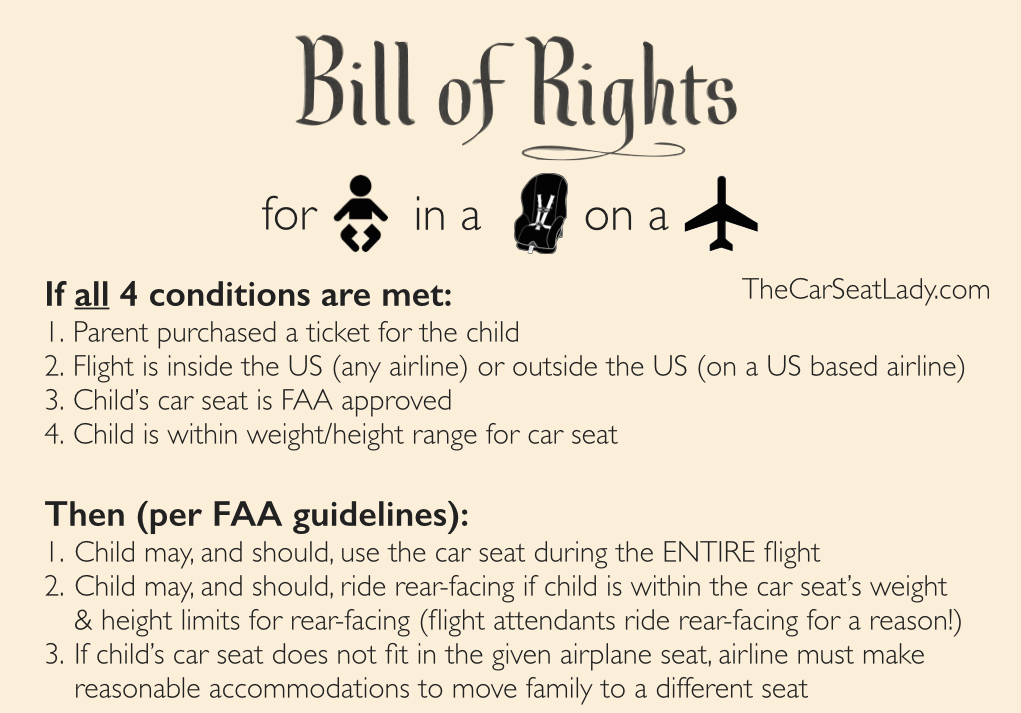
We’ve carefully detailed the pertinent parts of what we affectionately call “A Parent’s Car Seat Bill of Rights for the Airplane”… but what is officially known as Federal Aviation Administration’s Advisory Circular regarding Use of Child Restraint Systems on Aircraft. We suggest that you print the Advisory Circular and take it with you to the airport in case you need supporting documentation if questioned by an airline employee. Another helpful FAA document you may want to print out is this one here.
VERY IMPORTANT: The information on this page ONLY applies to flights within the US (on any airline) and flights outside the US on a US based carrier… it does not apply to flights outside the US on foreign airlines.
Sadly, foreign airlines get to make their own rules – and some don’t allow any car seats (no matter how much you spent on a ticket for your kid), some only allow forward-facing car seats for kids in a particular age range – typically 6-24 or 6-36 months, and some are kind and allow all FAA approved car seats. Find out if you can use a car seat on a foreign airline BEFORE purchasing a ticket!
What are we trying to do with this page?
We’re trying to clarify which seats are legally allowed on aircraft and how they can and cannot be installed and used on the plane. There’s so much confusion and misinformation on this topic, even (or especially) among airline personnel. Here’s a quick summary of what is allowed, and then a detailed look at the FAA text and regulations.
Can car seats be used on planes? Yes! Any car seat that has a label stating it is “certified for use in motor vehicles and aircraft” can be used on an airplane. Foreign seats (those purchased outside the US) can be used as long as they are labeled as meeting the standards of a foreign government or the United Nations. This includes infant seats, convertibles, forward-facing seats and combination seats with harnesses (often called “harnessed boosters,” these are allowed if used in 5-point harness mode). There is no prohibition against using a seat in rear-facing mode, and the car seat may be placed in a variety of locations on the plane as long as it does not prevent passengers from evacuating in an emergency. If the car seat doesn’t fit in an assigned seat, the airline is required to attempt to find a seat that will accomodate the car seat. (Remember, this applies ONLY to flights within the US on any carrier, and flights outside the US on a US based carrier. It does not apply to flights outside the US on foreign airlines.)
Are there seats that cannot be used on planes? Yes. Aircraft seats and seat belts are different from motor vehicle seats and seat belts, and crash tests have shown that the car seats listed below may not protect a child in an aircraft seat. Therefore, they are not allowed during take-off and landing, even though some have labels saying they are certified for aircraft use.
*Note: Combination car seats, sometimes also called boosters, are allowed if used in 5 point harness mode
No airline may “prohibit a child from using an approved CRS (Child Restraint System) when the parent/guardian purchases a ticket for the child.” (Section 10-d, page 8)
“No aircraft operator may prohibit a child from using an approved CRS when the parent/guardian purchases a seat for the child. If an approved CRS, for which a ticket has been purchased, does not fit in a particular seat on the aircraft, the aircraft operator has the responsibility to accommodate the CRS in another seat in the same class of service. The regulations also permit an aircraft operator to use its discretion in identifying the most appropriate forward-facing passenger seat location, considering safe operating practices.
For example:
A CRS with a base that is too wide to fit properly in a seat with rigid armrests can be moved to a seat with moveable armrests that can be raised to accommodate the CRS.
An aft-facing CRS that can not be installed properly, because of minimal pitch (distance between seats) between rows, can be moved to a bulkhead seat or a seat in a row with additional pitch.” (Section 10-f, page 8)
“CRSs must be installed in a forward-facing aircraft seat, in accordance with instructions on the label. This includes placing the CRS in the appropriate forward or aft-facing direction as indicated on the label for the size of the child.” (Section 19, page 14)
This is often misinterpreted by flight attendants to mean that the child’s car seat must face forward. But that’s not what this statement means! It means that the airplane seat must face forward (i.e face the front of the plane) – so if you’re assigned an airplane seat that faces the back of the plane, you can’t use that seat for the child’s car seat. The direction the child’s car seat faces – forward or aft (rear) – is based on the child’s age, weight, and height and whether they’re within the parameters for rear-facing or forward facing for that particular car seat.
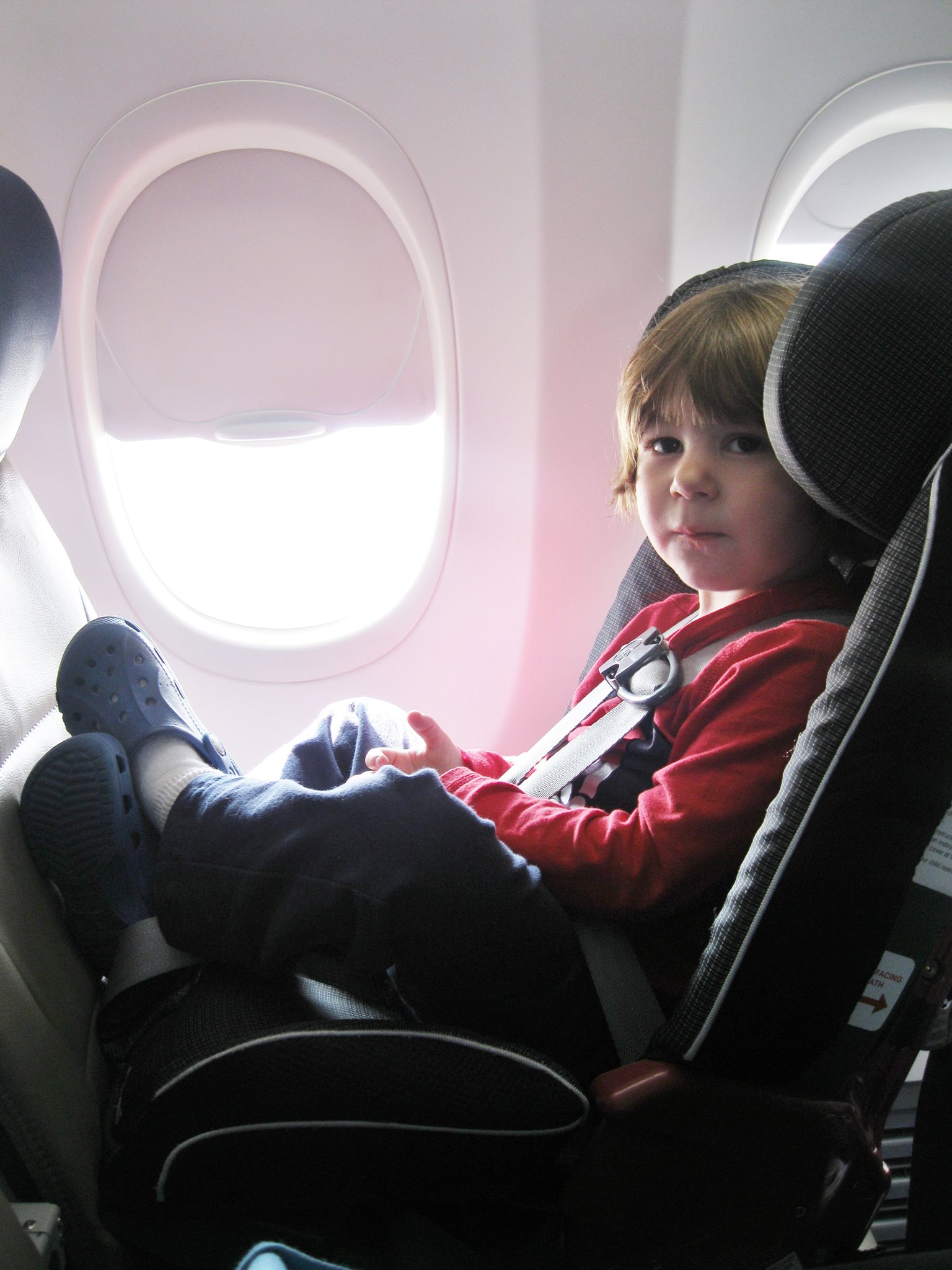
“A window seat is the preferred location; however, other locations may be acceptable, provided the CRS does not block the egress of any passenger, including the child’s parent or guardian, to the aisle used to evacuate the aircraft. The regulations…allow aircraft operators to determine the most appropriate passenger seat location for CRSs based on safe operating practices. In making this determination, an aircraft operator should consider the following:
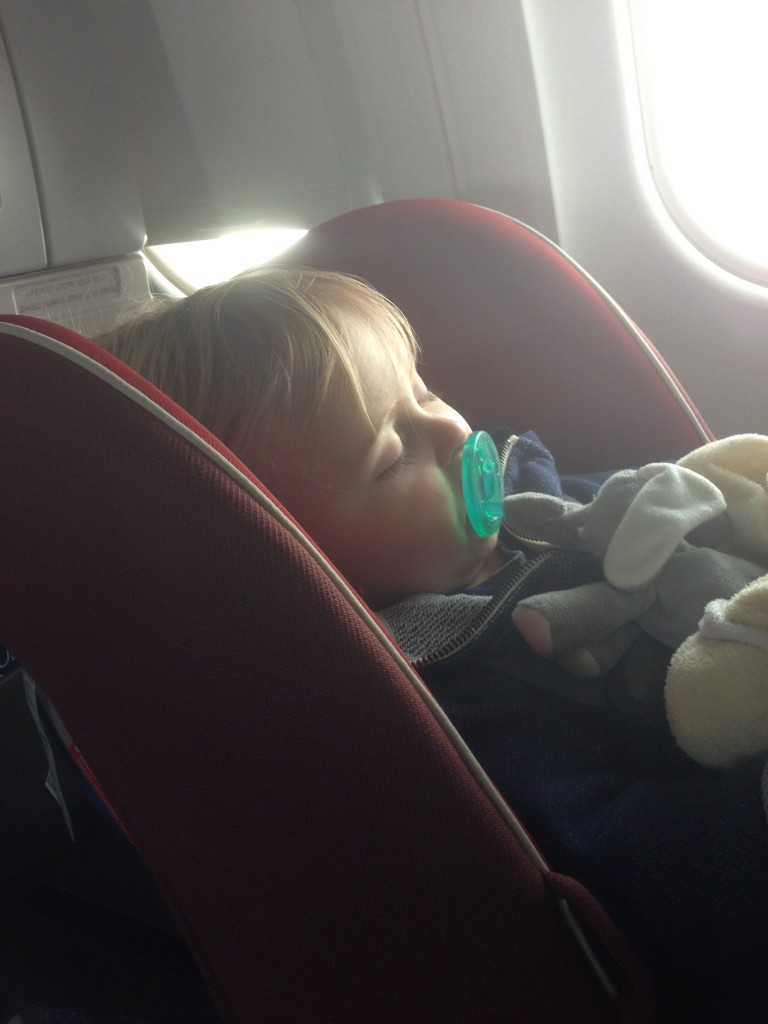
a. Aisle Seats. CRSs should not be placed in an aisle seat because this placement has the highest risk of slowing down the passenger flow rate during an evacuation. For example, a parent or guardian traveling with the child in a CRS may step out into the aisle to release the child from the CRS, or the CRS may impede F/As who may need to climb over the top of aisle seats to get past passengers in the aisle to reach an emergency exit.
b. Rows Forward and Aft of Emergency Exit Rows. Each aircraft operator’s specific evacuation procedures should be considered during the development of procedures regarding the placement of a CRS on aircraft.
(1) In an evacuation, space has to be rapidly cleared forward or aft of the exit row so that no one would be hurt or trapped if the exit hatch was thrown in this area. A delay may occur as a parent/guardian removes a child from a CRS. If the aircraft operator’s crewmember evacuation procedures or instructions to passengers demonstrate the removal and placement of Type III exit hatches…in the row forward or aft of the emergency exit row, the aircraft operator should restrict the placement of CRSs accordingly.
(2) Installation of a CRS in the row forward of an exit keeps a seat back from breaking over. Aircraft seats are not required to break over, but if an aircraft operates with this feature and evacuation procedures include breaking over seat backs forward of an exit to create space for a crewmember or to create a wider evacuation path for passengers, the aircraft operator should restrict the placement of CRSs accordingly.
“Aircraft operators should ensure F/As (flight attendants) are aware that older children (who have not reached their eighteenth birthday) may use a properly approved CRS that is appropriate for that child’s size and weight. In this case, the aircraft operator may not prohibit the use of the CRS.” (Section 23, page 13)
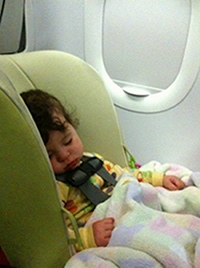
“Some manufacturers choose to market and label their approved CRSs with backs as “booster seats.”… these “booster seats” fall into two categories, those with and without internal restraints….With internal restraints, solid backs, and the proper labeling, these CRSs marketed as “booster seats” will be labeled as certified for use in motor vehicles and aircraft and may be used for all phases of flight.” (Section17a, page 13)
Basically, traditional boosters can’t be used on airplanes since boosters need a shoulder belt – and airplanes just have lap belts. However, if you are using the 5 point harness mode of a combination seat, you absolutely can use it on the airplane.
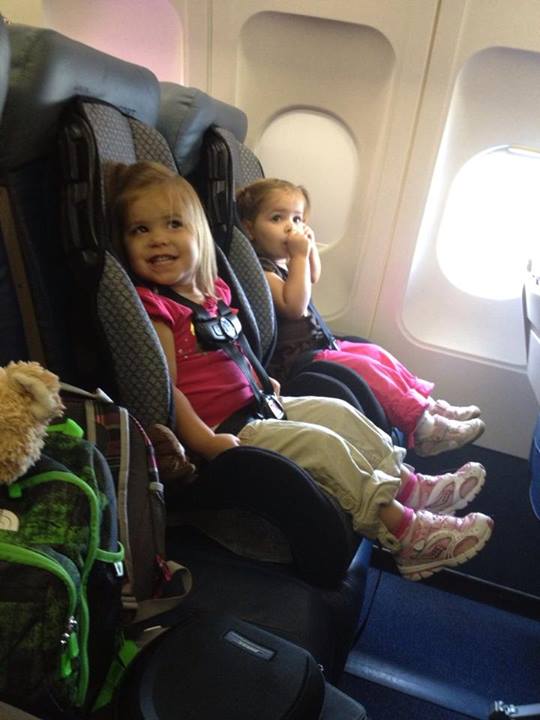
“When an approved CRS is labeled or marked by the manufacturer, it certifies the CRS meets a set of safety standards….When a parent/guardian presents an approved CRS for use on aircraft with a worn off or unreadable label, the CRS must be furnished with a letter or document from the manufacturer that specifically ties the CRS (through a detailed description or specific make and model number) to approval for use on aircraft. An owner’s manual is also acceptable as proof of safety standards….” (Section 12, page 10)
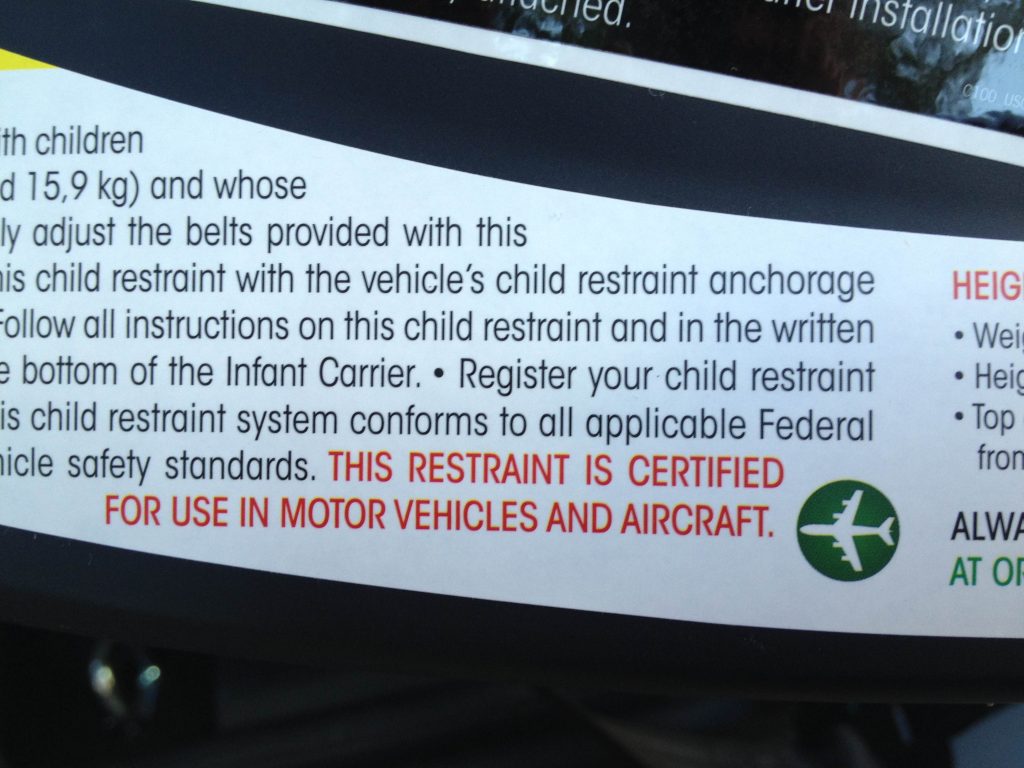
“The CRS must bear either a label showing approval of a foreign government or a label showing that the CRS was manufactured under the standards of the United Nations.” (Section 9b, page 6)
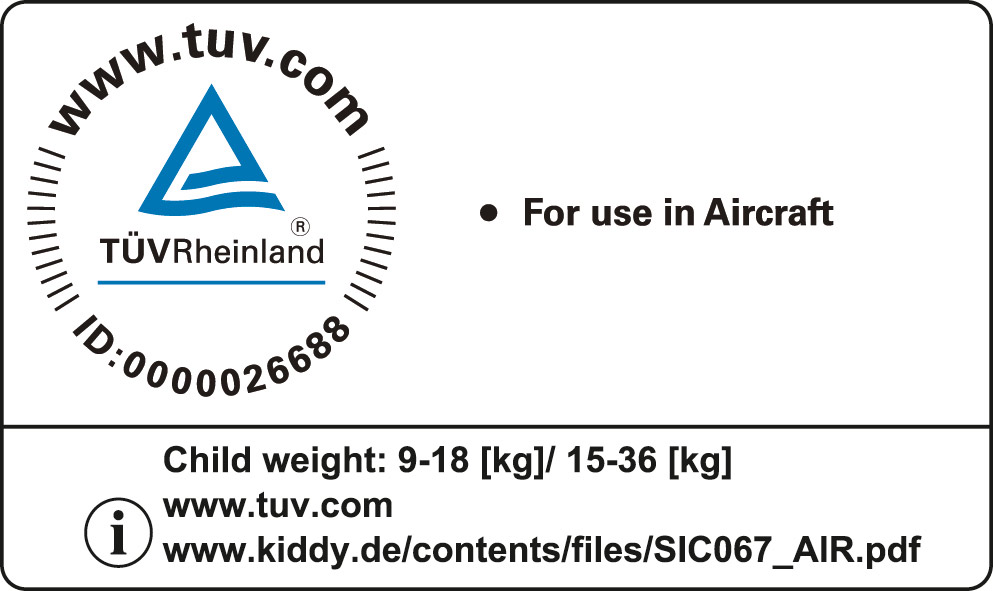
Some business & first class seats are not straight – they are turned at an angle (also known as oblique seats). If they are angled more than 18 degrees the FAA prohibits the use of a car seat on these oblique airplane seats. See here for more info.

We have carefully detailed below the pertinent parts of what we affectionately call “A Parent’s Car Seat Bill of Rights for the Airplane”… but what is officially known as Federal Aviation Administration’s Advisory Circular regarding Use of Child Restraint Systems on Aircraft. We suggest that you print the Advisory Circular and take it with you to the airport in case you need supporting documentation if questioned by an airline employee. Another helpful FAA document you may want to print out is this one here.
No airline may “prohibit a child from using an approved CRS (Child Restraint System) when the parent/guardian purchases a ticket for the child.” (Section 10-d, page 7)
If your car seat does not fit in your child’s assigned airplane seat, the airline has to try to find a different airplane seat that will accommodate the car seat.
“No aircraft operator may prohibit a child from using an approved CRS when the parent/guardian purchases a seat for the child. If an approved CRS, for which a ticket has been purchased, does not fit in a particular seat on the aircraft, the aircraft operator has the responsibility to accommodate the CRS in another seat in the same class of service. The regulations also permit an aircraft operator to use its discretion in identifying the most appropriate forward-facing passenger seat location, considering safe operating practices.
For example:
- A CRS with a base that is too wide to fit properly in a seat with rigid armrests can be moved to a seat with moveable armrests that can be raised to accommodate the CRS.
- An aft-facing CRS that can not be installed properly, because of minimal pitch (distance between seats) between rows, can be moved to a bulkhead seat or a seat in a row with additional pitch.” (Section 10-f, page 7)
“CRSs must be installed in forward-facing aircraft seats, in accordance with instructions on the label. This includes placing the CRS in the appropriate forward or aft-facing (rear-facing) direction as indicated on the label for the size of the child.” (Section 18, page 11)
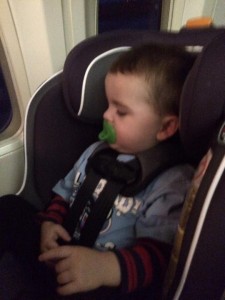
“A window seat is the preferred location; however, other locations may be acceptable, provided the CRS does not block the egress of any passenger, including the child’s parent or guardian, to the aisle used to evacuate the aircraft. The regulations…allow aircraft operators to determine the most appropriate passenger seat location for CRSs based on safe operating practices. In making this determination, an aircraft operator should consider the following.
- a. Aisle Seats. CRSs should not be placed in an aisle seat because this placement has the highest risk of slowing down the passenger flow rate during an evacuation. For example, a parent or guardian traveling with the child in a CRS may step out into the aisle to release the child from the CRS or the CRS may impede F/As (flight attendants) who may need to climb over the top of aisle seats to get past passengers in the aisle to reach an emergency exit.
- b. Rows Forward and Aft of Emergency Exit Rows. Each aircraft operator’s specific evacuation procedures should be considered during the development of procedures regarding placement of CRSs on aircraft.
In an evacuation, space has to be rapidly cleared forward or aft of the exit row so that no one would be hurt or trapped if the exit hatch was thrown in this area. A delay may occur as a parent/guardian removes a child from a CRS. If the aircraft operator’s crewmember evacuation procedures or instructions to passengers demonstrate the removal and placement of Type III exit hatches …in the row forward or aft of the emergency exit row, the aircraft operator should restrict the placement of CRSs accordingly.
- Installation of a CRS in the row forward of an exit keeps a seat back from breaking over. Aircraft seats are not required to break over, but if an aircraft operates with this feature and evacuation procedures include breaking over seat backs forward of an exit to create space for a crewmember or to create a wider evacuation path for passengers, the aircraft operator should restrict the placement of CRSs accordingly.” (Section 18, page 11)
“Aircraft operators should ensure F/As (flight attendants) are aware that older children (who have not reached their eighteenth birthday) may use a properly approved CRS that is appropriate for that child’s size and weight. In this case, the aircraft operator may not prohibit the use of the CRS.” (Section 23, page 13)
“Some manufacturers choose to market and label their approved CRSs with backs as “booster seats.”… these “booster seats” fall into two categories, those with and without internal restraints….With internal restraints, solid backs, and the proper labeling, these CRSs marketed as “booster seats” will be labeled as certified for use in motor vehicles and aircraft and may be used for all phases of flight.” (Section16b, pages 10-11)
Basically, traditional boosters can’t be used on airplanes since boosters need a shoulder belt – and airplanes just have lap belts. However, if you are using the 5 point harness mode of a combination seat, you absolutely can use it on the airplane.
“When an approved CRS is labeled or marked by the manufacturer, it certifies the CRS meets a set of safety standards….Current operating rules require the CRS used on an aircraft during ground movement, takeoff, and landing must bear labels or markings to indicate to the aircraft operator that the CRS meets safety standards. When a parent/guardian presents an approved CRS for use on aircraft with a worn off or unreadable label, the CRS must be furnished with a letter or document from the manufacturer that specifically ties the CRS (through a detailed description or specific make and model number) to approval for use on aircraft. An owner’s manual is also acceptable as proof of safety standards….” (Section 11, page 7)
“The CRS must bear either a label showing approval of a foreign government or a label showing that the CRS was manufactured under the standards of the United Nations.” (Section 9b, page 5)
Some business & first class seats are not straight – they are turned at an angle (also known as oblique seats). If they are angled more than 18 degrees the FAA prohibits the use of a car seat on these oblique airplane seats. See here for more info.
